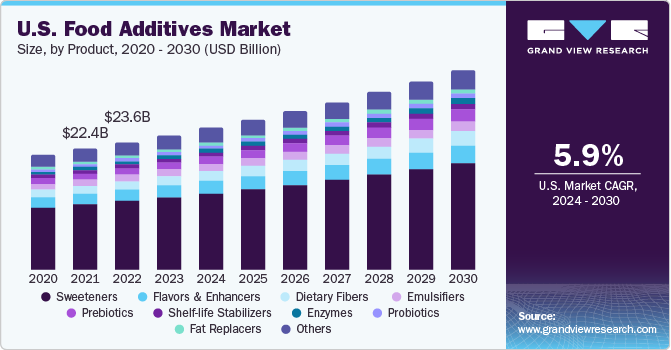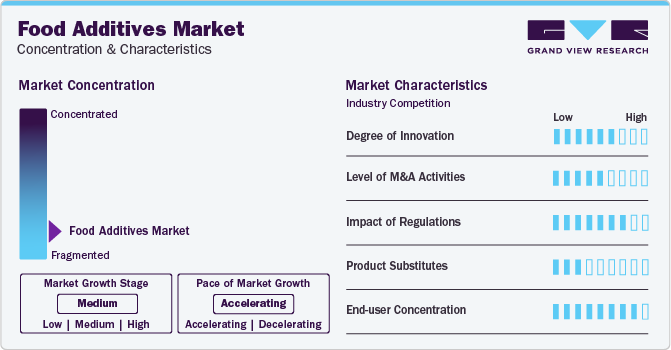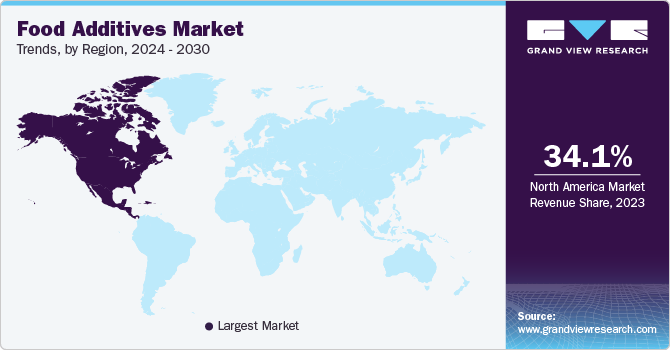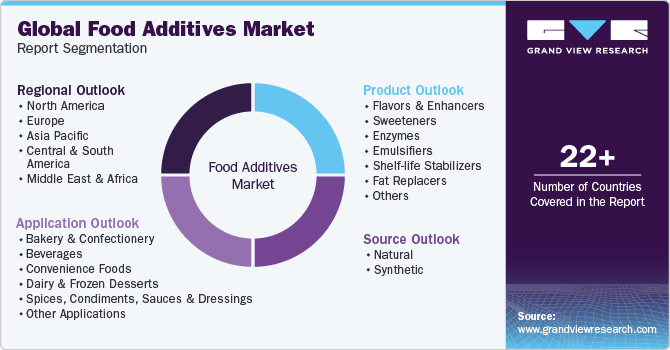- Home
- »
- Food Additives & Nutricosmetics
- »
-
Food Additives Market Size, Share & Trends Report, 2030GVR Report cover
![Food Additives Market Size, Share & Trends Report]()
Food Additives Market Size, Share & Trends Analysis Report By Product, By Source (Natural, Synthetic), By Application (Bakery & Confectionery, Beverages), By Region, And Segment Forecasts, 2024 - 2030
- Report ID: 978-1-68038-187-0
- Number of Report Pages: 125
- Format: PDF, Horizon Databook
- Historical Range: 2018 - 2022
- Forecast Period: 2024 - 2030
- Industry: Specialty & Chemicals
Food Additives Market Size & Trends
The global food additives market size was estimated at USD 114.35 billion in 2023 and is expected to grow at a compound annual growth rate (CAGR) of 5.8% from 2024 to 2030. This is attributed to the expanding size of key end-use sectors, including bakery & confectionery, beverages, dairy, and convenience foods, coupled with the growing penetration of organized as well as e-retail, fueling the market growth.

Specialty food ingredients are utilized in products to enhance their properties such as taste, shelf life, texture, and health benefits. The market is classified into sensory ingredients and functional ingredients. Sensory ingredients are vital for enhancing the taste, smell, flavor, and texture of products. Functional ingredients include vitamins, acidulates, antioxidants, and other constituents that add nutritional qualities to food.
Higher expenditure on food & beverage products in the U.S. compared to other countries across the globe due to the overall high disposable incomes of the U.S. population has increased the production of food & beverage products in the country. This can be attributed to increasing demand, which is likely to result in the growing consumption of additives in these products. Increased demand is expected to support the consumption of fat replacers and high-intensity sweeteners that lower the fat content and sugar content of food or drinks. In November 2020, BLUE CALIFORNIA launched the Destination Flavors Collection for ready-to-drink (RTD) alcoholic beverages comprising lower sugar content. The flavours offered are inspired by regional flavours such as Catalan Crush, Arctic Gem, Pacific Blossom, Thai Treat, and California Dreamin.
The consumption of packaged food products and beverages is rising globally. This is expected to contribute to the surging demand for additives used during the processing of various packaged products and beverages. For instance, according to the survey results published by the Food Standards Agency in May 2021, approximately 81.0% of survey respondents in the UK confirmed buying processed food products from April 2020 to March 2021. Rising demand for packaged products and beverages is expected to fuel the market growth of worldwide.
Companies operating in the global market are subjected to various laws, regulations, and guidelines imposed by government authorities operating in a particular region. Some of the regulatory bodies governing additives and their end-use industries include the U.S. Food and Drug Administration (FDA), the Food Agriculture Organization (FAO), and the World Health Organization (WHO). These regulatory bodies have become increasingly active in ensuring the use of safe food additives in consumer products.
Market Characteristics
The market concentration of the food additives industry is characterized by the presence of many players and their role in driving market dynamics. This gives the additive market a highly fragmented nature with key industry participants such as ADM, Chr. Hansen Holding A/S, Ingredion Incorporated. These companies contribute to the market's concentration through their significant market share, product offerings, and research and development initiatives. These major players often play a crucial role in shaping industry trends, technological innovations, and market strategies, thereby influencing the overall concentration of the market growth.

Technological advancements and ongoing innovations in food additives contribute to the market concentration by creating barriers to entry for new players and reinforcing the competitive positions of established industry leaders. The role of key players in driving innovation and product development further solidifies their influence on market concentration, as they continue to introduce novel additives, enhance production processes, and expand their product portfolios. Although the variety of end user applications and low level of technological requirements aid the entry of new players into the market. These factors collectively contribute to the low market concentration of the food additives industry.
Moreover, the market characteristics of the food additives industry are influenced by the multifunctional roles served by additives, including their ability to enhance taste, texture, appearance, and shelf life of products. This aligns with the increasing consumer inclination towards clean labelled products, driving the demand for additives that contribute to product quality and safety.
The industry's focus on compliance with regulatory standards and safety assessments, such as those conducted by the Joint FAO/WHO Expert Committee on Food Additives (JECFA), underscores the importance of ensuring the safety and efficacy of food additives for consumer consumption.
Product Insights
Based on product, the sweeteners led the market with a largest revenue share of 55.6% in 2023. This is attributed to rising demand for sweet products, such as confections and soft drinks, which has resulted in an increased demand for high fructose corn syrup. High fructose corn syrup, which has a high glycemic index, is considered a high caloric sweetener as it increases the calorie content of food products to which it is added. According to the Food & Agricultural Organization (FAO), global caloric sweeteners production is expected to reach 218 million tons by 2029. However, rising awareness among the population regarding health concerns due to excessive intake of high calorific foods is expected to limit the demand for HFCS.
The demand for chocolates, candies, baked goods, and non-alcoholic beverages is soaring from the young population globally. Moreover, according to Döhler GmbH, approximately 73% of the total confectionary consumers demand a healthier and more natural confectionary. This is expected to fuel the demand for sweeteners over the forecast period.
The flavors & enhancers are another major product segment in the global market. The segment includes flavoring agents, enhancers, carriers, modulators, bitterness suppressors, and flavor emulsions, among others. Flavoring agents effectively mask unpleasant taste and improve the taste of food & beverages. Rising health consciousness and awareness regarding the side effects of artificial flavors, such as allergies and risk of cancer, has encouraged market players to focus on naturally derived ingredients.
Essential oils or oleoresins-based flavors are extracted from naturally available plant sources such as fruit pulp, fruit peel, leaves, and seeds. Commonly used sources for oleoresins include turmeric, ginger, garlic, rosemary, vanilla, and cocoa. Increasing consumer preference for natural and organic products is projected to fuel the demand for natural flavors from dairy, frozen desserts, and beverage manufacturers.
The Sweeteners used in the food & beverage industry include, proteases, lipases, carbohydrases, alpha amylase, glucoamylase, lactase, phospholipase, esterase, cellulose, pectinase, xylanase, glucose oxidase, laccase, catalase, and peroxidase among others. Protease breaks down proteins, i.e. the catalytic hydrolysis of protein peptides to amino acids. Proteases are used to produce infant milk formulations and develop a specific flavor for different types of proteins.
Source Insights
Based on source, the natural source led the market with a largest revenue share of 82.6% in 2023. This is attributable to the growing preference for natural and organic products among consumers. The natural segment comprises additives that are derived from naturally available sources like various parts of plants such as dietary fibers derived from fruit peels; animal sources such as milk or egg proteins or microorganisms such as probiotic strains including lactic acid bacteria. The rising trend of veganism is expected to augment the demand for plant-based ingredients globally. Therefore, the market players are also shifting to this trend by launching several plant-based meat products.
The synthetic source segment comprises additives that are chemically synthesized from raw materials. Different food additives are synthesized from different raw materials following different chemical reactions. For instance, sweeteners such as saccharin are synthesized by the oxidation of o-toluene sulfonamide to the corresponding carboxylic acid by reacting with potassium permanganate or chromic acid.
Similarly, food emulsifiers are synthesized by chemical reactions of hydrophilic (poly) alcohols such as polyglycerol, propylene glycol, sorbitol, and sucrose with vegetable oils or fats. Monoglycerides are esterified with lactic acid, citric acid, or acetic acid anhydride to produce other emulsifiers such as lactic acid esters of mono-and diglycerides of fatty acids. Artificial flavors such as esters are made synthetically by reacting carboxylic acids and alcohol together during a condensation reaction. Aldehyde flavors are formed by the partial oxidation of primary alcohols to form carboxylic acids when they are further oxidized.
Application Insights
In terms of application, the bakery & confectionary segment led the market with a largest revenue share of 30.38% in 2023. Its high share is attributable to rising usage of Bakery & confectionery products including bread, cakes, biscuits, tortillas, and sugar & chocolate confections, among others. Sweeteners, flavors, sweeteners, fat replacers, and shelf-life stabilizers are the food additives commonly used in bakery and confectionery products. Rising utilization of enzymes to enhance dough stability and increase the shelf life of bakery products is anticipated to fuel the market growth.

Dietary fibers such as cellulose with low water absorption ability are majorly used to offer fiber enrichment in bakery products such as tortillas and bread. Higher consumption of bread and bread-based products in North American and European countries is expected to drive the demand for dietary fibers in bakery products.
The beverages industry is another major application of market. The consumption of alcoholic and non-alcoholic beverages has been increasing globally for the past decade. The growth of the market for alcoholic beverages is driven by the millennial population, specifically in developed countries of North America and Europe with alcohol consumption as a part of their culture. The presence of leading players, such as Anheuser-Busch InBev, SABMiller, and Heineken that offer standard- and premium-quality alcoholic beverages in these regions is fueling the consumption of beverages in North America and Europe.
Dairy & frozen products use food additives in various products such as dairy products and frozen desserts include yogurt, flavored milk, smoothies, ice cream, whipped cream, and sweetened cream cheese, among others. Rising awareness of animal welfare and shifting consumer preferences toward vegan products, such as non-dairy alternatives, including oat milk and soy milk, are expected to hamper the consumption of dairy beverages. This, in turn, is anticipated to limit the demand for additives, specifically developed for dairy products.
Regional Insights
The North America dominated the market with a revenue share of 34.1% in 2023. This is attributed to the rise in consumption of chemicals by numerous industries like pharmaceuticals, industrial, and food & beverages. In addition, expanding pharmaceutical industry in countries such as U.S., Mexico and Canada is anticipated to surge the demand in North America.

Europe is run by major industrial economies such as the UK, Germany, France, Italy, and others. It is characterized by the presence of an increasing number of manufacturers and suppliers of food & beverage, cosmetics, and pharmaceutical products penetrating the regional ecosystem. The presence of major cosmetic manufacturing companies in the region is expected to drive the demand for food additives.
Pharmaceutical, personal care & cosmetics, and food & beverage applications all have an impact on the demand for additives. The rising purchasing power parity, rising income levels, and expanding populations in nations like China and India have all contributed to the increased demand for the aforementioned goods. Additionally, over the projection period, a lot of industries are expected to see an increase in demand due to the quickly expanding number of food and beverage start-ups, particularly in India.
Key Food Additives Company Insights
The competitive landscape of the market is characterized by the presence of key players such as ADM, BASF SE, Chr. Hansen Holding A/S, Ingredion Incorporated, Novozymes A/S, Tate & Lyle Plc, DSM, Ajinomoto Co., Inc; Cargill, Incorporated, Givaudan, International Flavors & Fragrances, Inc., Biospringer, Palsgaard, and Lonza. These companies are actively engaged in strategic activities such as new product launches, contractual agreements, mergers and acquisitions, higher investments, and collaboration with other organizations to expand their footprint and enhance their market presence.
Some of the key players operating in the market include
-
BASF SE offers a wide range of food additives, including enzymes, organic acids, and alcohol, catering to various industries such as food and beverages, pharmaceuticals, and plastics. BASF SE has collaborated with other companies to open precision fermentation facilities in Singapore, showcasing their commitment to expanding their presence in the market
-
ADM (Archer Daniels Midland Company) is a global leader in nutrition and agricultural processing, offering a diverse range of products and services. In the context of food additives, ADM's offerings include a wide array of agricultural commodities, ingredients, flavors, and specialty food ingredients catering to the food and beverage, animal nutrition, and industrial markets
-
Kerry Group and Biospringer are some of the emerging market participants in the market.
-
Biospringer, a division of Lesaffre, specializes in yeast extract-based ingredients, offering natural flavor solutions for the food, beverage, and nutrition industries. The company's offerings include yeast extracts, yeast-based flavors, and natural ingredients, catering to diverse applications such as savory products, snacks, soups, sauces, and plant-based foods
-
Kerry Group, a global taste and nutrition company, operates through the Taste & Nutrition and Consumer Foods segments. The Taste & Nutrition segment offers a wide range of savory, sweet, and beverage systems, functional ingredients, and nutritional solutions for the food and beverage industry
Key Food Additives Companies:
The following are the leading companies in the food additives market. These companies collectively hold the largest market share and dictate industry trends. Financials, strategy maps & products of these food additives companies are analyzed to map the supply network.
- ADM
- Chr. Hansen Holding A/S
- Ingredion Incorporated
- Novozymes A/S
- Tate & Lyle Plc
- DSM
- Ajinomoto Co., Inc
- Cargill, Incorporated
- BASF SE
- Givaudan
- International Flavors & Fragrances, Inc.
- Biospringer
- Palsgaard
- Lonza
- Sensient Technologies Corporation
- Kerry
- Corbion
- Fooding Group Limited
- DuPont
- The Kraft Heinz Company
Recent Developments
-
In August 2023, BASF SE increased their production capacity by 25% for medium-molecular weight polyisobutanes in its production facility in Ludwigshafen, Germany
-
In October 2023, ADM announced its investment decision in Guadalajara Production Line. The company invested USD 33 million in order to strengthen its position in Human Nutrition and Animal Care segment
Food Additives Market Report Scope
Report Attribute
Details
Market size value in 2024
USD 120.53 billion
Revenue forecast in 2030
USD 169.22 billion
Growth rate
CAGR of 5.8% from 2024 to 2030
Base year for estimation
2023
Historical data
2018 - 2022
Forecast period
2024 - 2030
Quantitative units
Revenue in USD million/billion and CAGR from 2024 to 2030
Report coverage
Revenue forecast, company ranking, competitive landscape, growth factors, and trends
Segments covered
Product, application, region
Regional scope
North America; Europe; Asia Pacific; Central & South America; Middle East Africa
Country scope
U.S.; Canada; Mexico; Germany; UK; France; Italy; Spain; China; India; Japan; South Korea; Australia; Brazil; Argentina; South Africa; Saudi Arabia
Key companies profiled
BASF SE; ADM; Chr. Hansen Holding A/S; Ingredion Incorporated; Novozymes A/S; Tate & Lyle Plc; DSM; Ajinomoto Co., Inc; Cargill Incorporated; Givaudan; International Flavors & Fragrances, Inc.; Biospringer; Palsgaard; Lonza; Sensient Technologies Corporation; Kerry; Corbion; Fooding Group Limited; DuPonte Kraft Heinz Company
Customization scope
Free report customization (equivalent up to 8 analyst’s working days) with purchase. Addition or alteration to country, regional & segment scope.
Pricing and purchase options
Avail customized purchase options to meet your exact research needs. Explore purchase options
Global Food Additives Market Report Segmentation:
This report forecasts revenue growth at global, regional, and country levels and provides an analysis of the latest industry trends in each of the sub-segments from 2018 to 2030. For this study, Grand View Research has segmented the global food additives market report based on product, source, application and region.

-
Product Outlook (Revenue, USD Million, 2018 - 2030)
-
Flavors & Enhancers
-
Sweeteners
-
Enzymes
-
Emulsifiers
-
Shelf-life Stabilizers
-
Fat Replacers
-
Prebiotics
-
Probiotics
-
Dietary Fibers
-
Others
-
-
Source Outlook (Revenue, USD Million, 2018 - 2030)
-
Natural
-
Synthetic
-
-
Application Outlook (Revenue, USD Million, 2018 - 2030)
-
Bakery & confectionery
-
Beverages
-
Convenience Foods
-
Dairy & Frozen Desserts
-
Spices, Condiments, Sauces & Dressings
-
Other Applications
-
-
Regional Outlook (Revenue, USD Million, 2018 - 2030)
-
North America
-
U.S.
-
Canada
-
Mexico
-
-
Europe
-
Germany
-
UK
-
France
-
Italy
-
Spain
-
-
Asia Pacific
-
China
-
Japan
-
India
-
South Korea
-
-
Central & South America
-
Australia
-
Brazil
-
Argentina
-
-
Middle East and Africa
-
Saudi Arabia
-
South Africa
-
-
Frequently Asked Questions About This Report
b. The global food additives market size was estimated at USD 114.35 billion in 2023 and is expected to reach USD 120.53 billion in 2024.
b. The global food additives market is expected to grow at a compound annual growth rate of 5.8% from 2024 to 2030 to reach USD 169.22 billion by 2030
b. The sweeteners segment dominated the food additives market with a share of nearly 55.7% in 2023 owing to its widespread usage in several food & beverage applications
b. Some of the key players operating in the global food additives market include ADM; Chr. Hansen Holding A/S; Ingredion Incorporated; Novozymes A/S; Tate & Lyle Plc; DSM; Ajinomoto Co., Inc.; Cargill, Incorporated; BASF SE; Givaudan; International Flavors & Fragrances, Inc.; and others.
b. The key factors that are driving the global food additives market include the requirement to improve taste, texture, mouthfeel, and overall appearance of food and beverages. The growing food and beverages industry globally is the key factor driving the market.
Share this report with your colleague or friend.
![gvr icn]()
NEED A CUSTOM REPORT?
We can customize every report - free of charge - including purchasing stand-alone sections or country-level reports, as well as offer affordable discounts for start-ups & universities. Contact us now
![Certified Icon]()
We are GDPR and CCPA compliant! Your transaction & personal information is safe and secure. For more details, please read our privacy policy.
We are committed towards customer satisfaction, and quality service.
"The quality of research they have done for us has been excellent."





